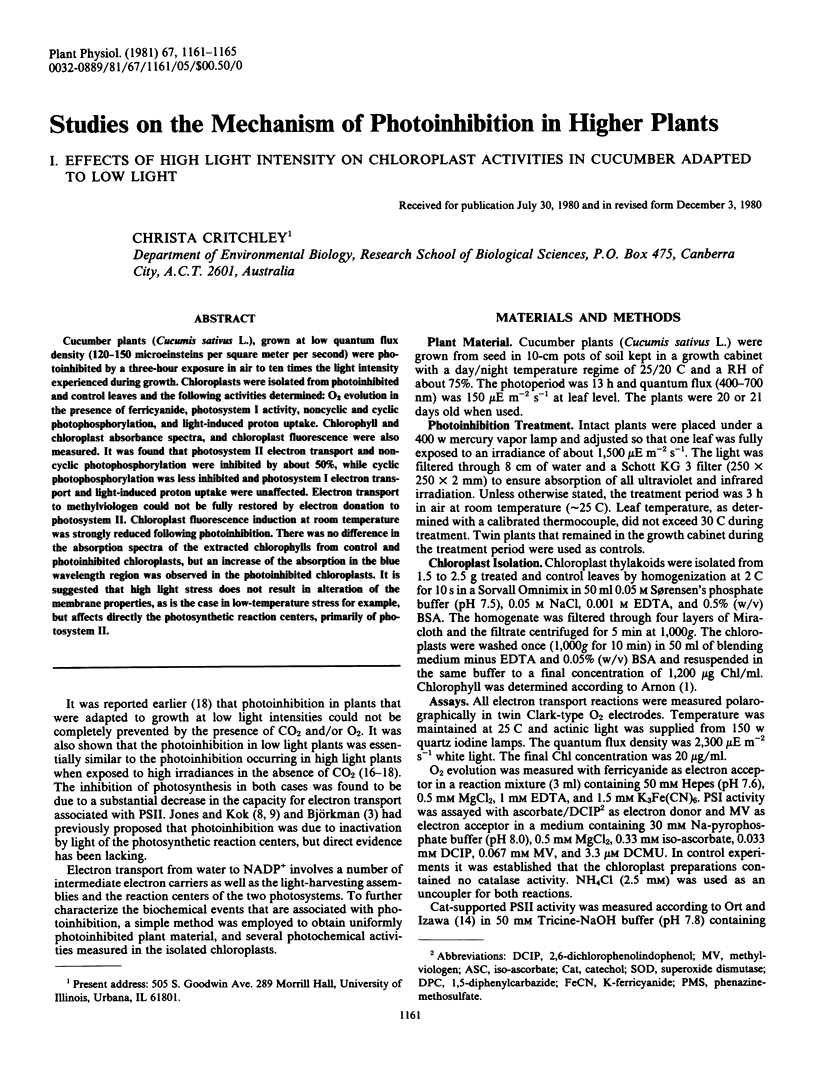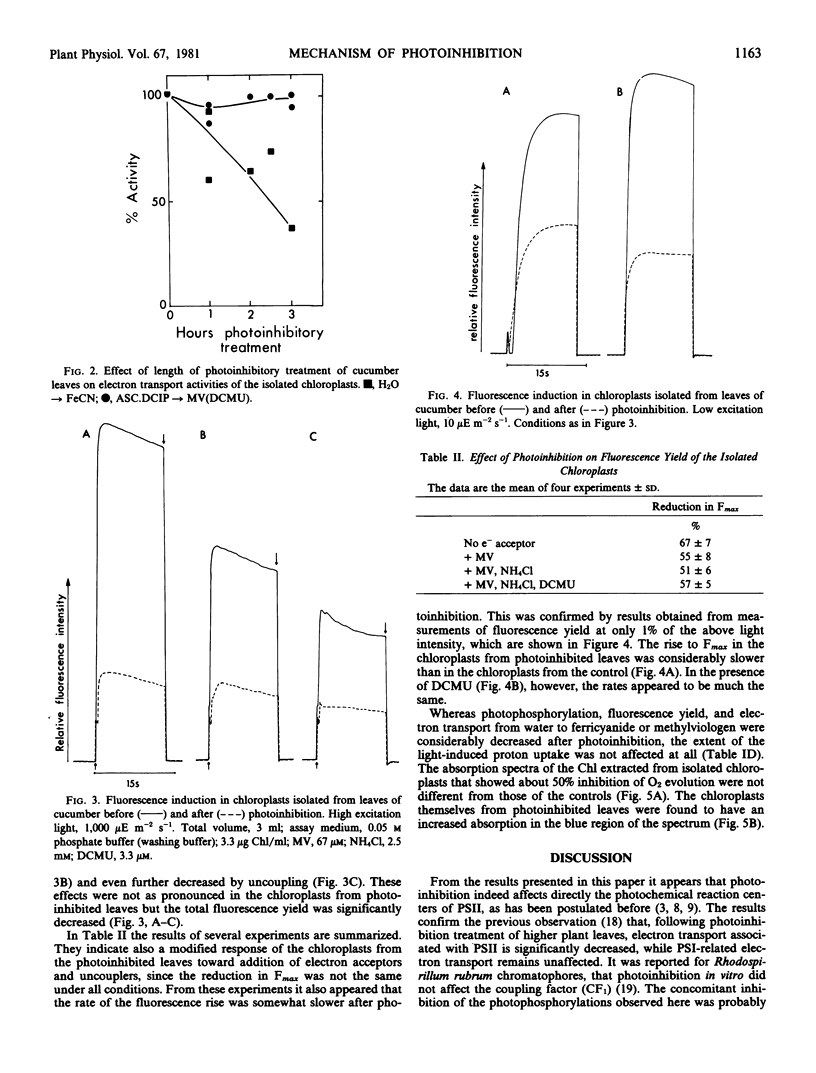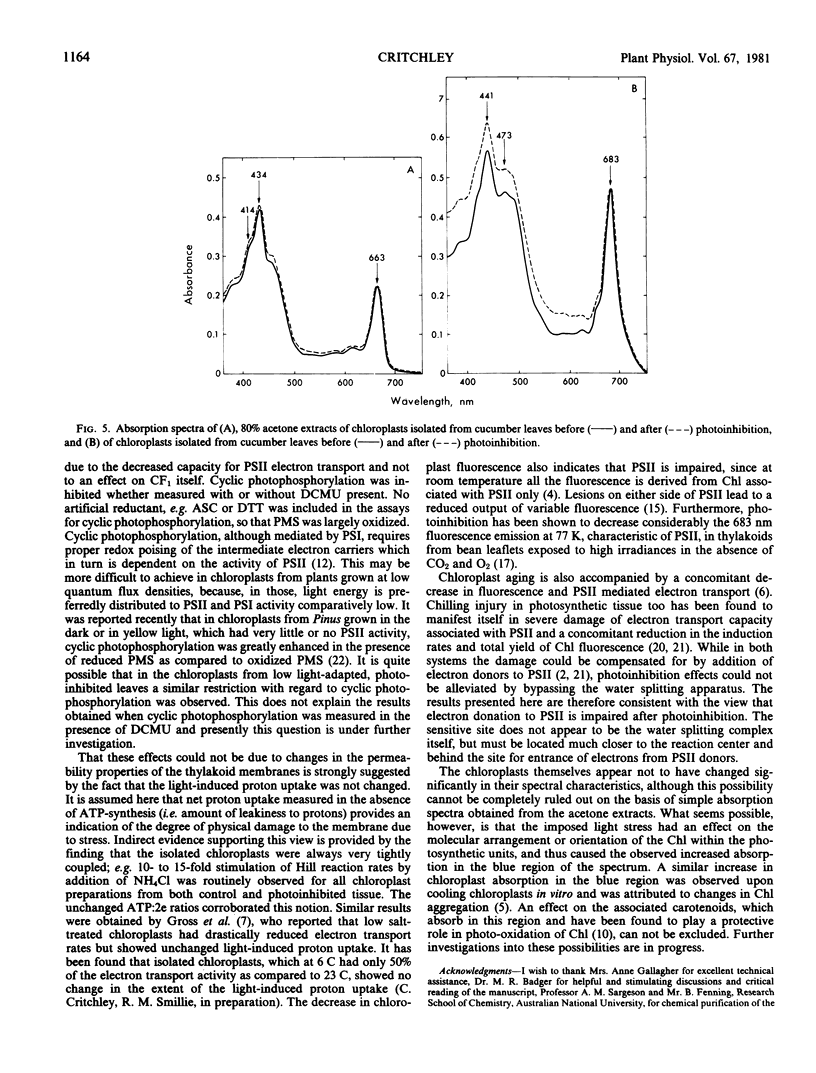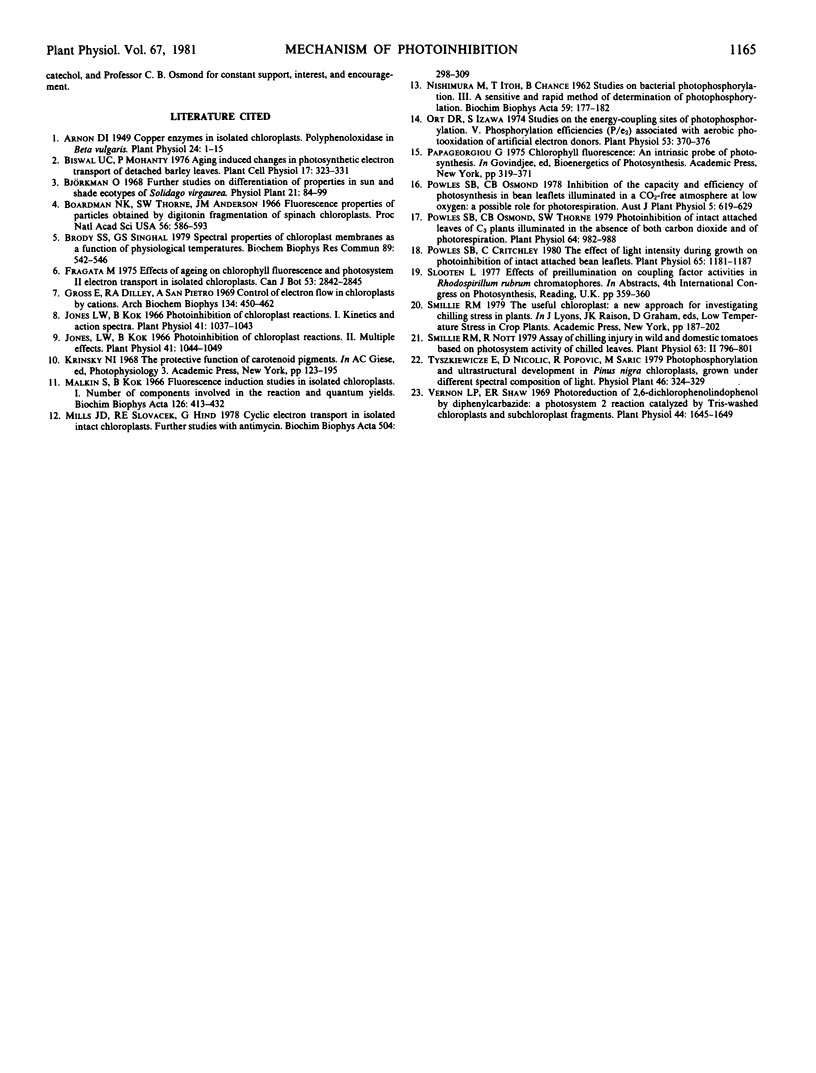Abstract
Cucumber plants (Cucumis sativus L.), grown at low quantum flux density (120-150 microeinsteins per square meter per second) were photoinhibited by a three-hour exposure in air to ten times the light intensity experienced during growth. Chloroplasts were isolated from photoinhibited and control leaves and the following activities determined: O2 evolution in the presence of ferricyanide, photosystem I activity, noncyclic and cyclic photophosphorylation, and light-induced proton uptake. Chlorophyll and chloroplast absorbance spectra, and chloroplast fluorescence were also measured. It was found that photosystem II electron transport and non-cyclic photophosphorylation were inhibited by about 50%, while cyclic photophosphorylation was less inhibited and photosystem I electron transport and light-induced proton uptake were unaffected. Electron transport to methylviologen could not be fully restored by electron donation to photosystem II. Chloroplast fluorescence induction at room temperature was strongly reduced following photoinhibition. There was no difference in the absorption spectra of the extracted chlorophylls from control and photoinhibited chloroplasts, but an increase of the absorption in the blue wavelength region was observed in the photoinhibited chloroplasts. It is suggested that high light stress does not result in alteration of the membrane properties, as is the case in low-temperature stress for example, but affects directly the photosynthetic reaction centers, primarily of photosystem II.
Full text
PDF




Selected References
These references are in PubMed. This may not be the complete list of references from this article.
- Arnon D. I. COPPER ENZYMES IN ISOLATED CHLOROPLASTS. POLYPHENOLOXIDASE IN BETA VULGARIS. Plant Physiol. 1949 Jan;24(1):1–15. doi: 10.1104/pp.24.1.1. [DOI] [PMC free article] [PubMed] [Google Scholar]
- Boardman N. K., Thorne S. W., Anderson J. M. Fluorescence properties of particles obtained by digitonin fragmentation of spinach chloroplasts. Proc Natl Acad Sci U S A. 1966 Aug;56(2):586–593. doi: 10.1073/pnas.56.2.586. [DOI] [PMC free article] [PubMed] [Google Scholar]
- Brody S. S., Singhal G. S. Spectral properties of chloroplast membranes as a function of physiological temperatures. Biochem Biophys Res Commun. 1979 Jul 27;89(2):542–546. doi: 10.1016/0006-291x(79)90663-6. [DOI] [PubMed] [Google Scholar]
- Gross E., Dilley R. A., San Pietro A. Control of electron flow in chloroplasts by cations. Arch Biochem Biophys. 1969 Nov;134(2):450–462. doi: 10.1016/0003-9861(69)90305-1. [DOI] [PubMed] [Google Scholar]
- Jones L. W., Kok B. Photoinhibition of Chloroplast Reactions. II. Multiple Effects. Plant Physiol. 1966 Jun;41(6):1044–1049. doi: 10.1104/pp.41.6.1044. [DOI] [PMC free article] [PubMed] [Google Scholar]
- Jones L. W., Kok B. Photoinhibition of chloroplast reactions. I. Kinetics and action spectra. Plant Physiol. 1966 Jun;41(6):1037–1043. doi: 10.1104/pp.41.6.1037. [DOI] [PMC free article] [PubMed] [Google Scholar]
- Malkin S., Kok B. Fluorescence induction studies in isolated chloroplasts. I. Number of components involved in the reaction and quantum yields. Biochim Biophys Acta. 1966 Nov 8;126(3):413–432. doi: 10.1016/0926-6585(66)90001-x. [DOI] [PubMed] [Google Scholar]
- Mills J. D., Slovacek R. E., Hind G. Cyclic electron transport in isolated intact chloroplasts. Further studies with antimycin. Biochim Biophys Acta. 1978 Nov 9;504(2):298–309. doi: 10.1016/0005-2728(78)90178-0. [DOI] [PubMed] [Google Scholar]
- NISHIMURA M., ITO T., CHANCE B. Studies on bacterial photophosphorylation. III. A sensitive and rapid method of determination of photophosphorylation. Biochim Biophys Acta. 1962 May 7;59:177–182. [PubMed] [Google Scholar]
- Ort D. R., Izawa S. Studies on the Energy-coupling Sites of Photophosphorylation: V. Phosphorylation Efficiencies (P/e(2)) Associated with Aerobic Photooxidation of Artificial Electron Donors. Plant Physiol. 1974 Mar;53(3):370–376. doi: 10.1104/pp.53.3.370. [DOI] [PMC free article] [PubMed] [Google Scholar]
- Powles S. B., Critchley C. Effect of Light Intensity during Growth on Photoinhibition of Intact Attached Bean Leaflets. Plant Physiol. 1980 Jun;65(6):1181–1187. doi: 10.1104/pp.65.6.1181. [DOI] [PMC free article] [PubMed] [Google Scholar]
- Powles S. B., Osmond C. B. Photoinhibition of intact attached leaves of c(3) plants illuminated in the absence of both carbon dioxide and of photorespiration. Plant Physiol. 1979 Dec;64(6):982–988. doi: 10.1104/pp.64.6.982. [DOI] [PMC free article] [PubMed] [Google Scholar]
- Smillie R. M., Nott R. Assay of chilling injury in wild and domestic tomatoes based on photosystem activity of the chilled leaves. Plant Physiol. 1979 May;63(5):796–801. doi: 10.1104/pp.63.5.796. [DOI] [PMC free article] [PubMed] [Google Scholar]
- Vernon L. P., Shaw E. R. Photoreduction of 2,6-dichlorophenolindophenol by diphenylcarbazide: a photosystem 2 reaction catalyzed by tris-washed chloroplasts and subchloroplast fragments. Plant Physiol. 1969 Nov;44(11):1645–1649. doi: 10.1104/pp.44.11.1645. [DOI] [PMC free article] [PubMed] [Google Scholar]


